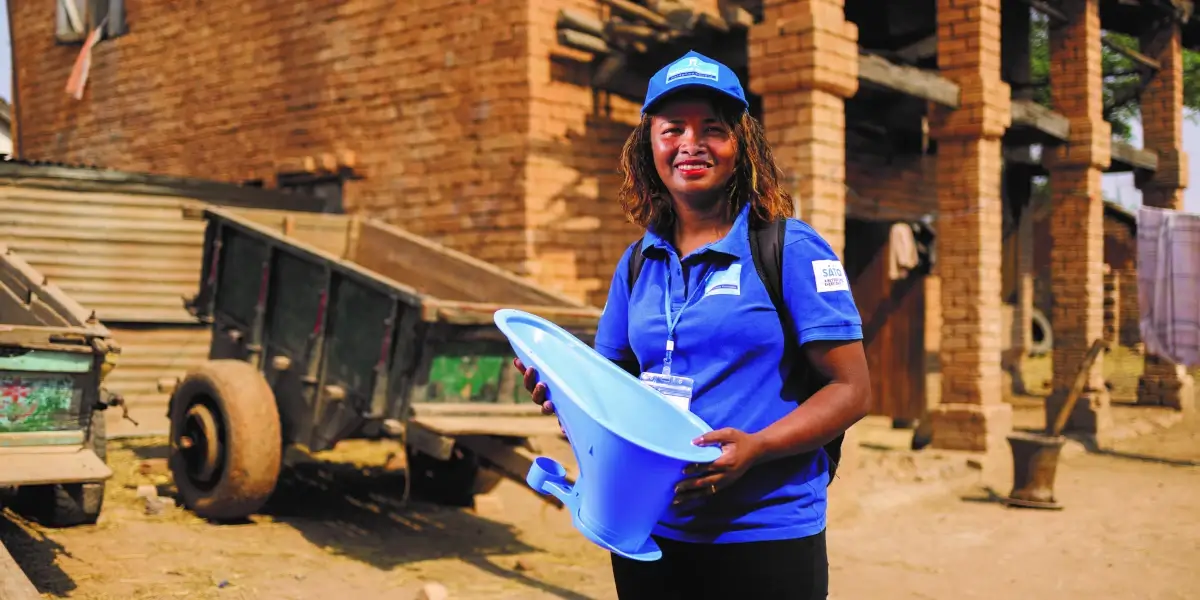
Hygiene and sanitation are everyone’s business

With water scarcity a growing reality, businesses have a clear incentive to look beyond their own operations and invest in resilient hygiene and sanitation for local communities.
Erin McCusker, Leader, SATO, a part of LIXIL
Our climate is changing. This fact is inescapable even if promises from COP26 are delivered. Estimates show that, based on commitments for the next decade, the world is on track for 2.4°C of warming. Even best-case scenarios see temperatures 1.8°C higher by 2100.1 While the latter is far preferable to business as usual, both trajectories have us heading for dual crises of heat and water scarcity.
These incredible shifts coincide with critical instability in the availability of water. A changing climate is resulting in a higher frequency, intensity and timing of extreme weather events like droughts and flooding2. Today, this is impacting a fifth of the world’s water basins, which is reducing the availability of potable water.3
With demand set to increase by 55% over the next 30 years—catalysed by an ever-changing climate—3.2 billion people are expected to face severe water scarcity by the mid-century.4 Meanwhile, by 2040, UNICEF estimates than 1 in 4 children will live in areas with high water stress5.
With water running low and heat rising, households in developing countries could soon face a stark choice—hydration or hygiene. In this situation, hygiene and sanitation will inevitably come second to the immediate need for safe drinking water. The costs to society, however, would be huge. Contaminated water and poor sanitation are linked to the transmission of diseases such as cholera, diarrhoea and polio. While access to managed sanitation has increased almost 20% since 2000, 829,000 preventable deaths caused by the transmission of diseases still occur every year among people unable to access a clean toilet and working tap.6 Sadly, this includes 297,000 children under five years old—an avoidable figure if these risk factors were addressed.7
A collapse in hygiene and sanitation rates is not just a health risk—the shockwaves would spill over to businesses. Poor access to sanitation costs the global economy more than $300 billion every year,8 with a lack of adequate toilets and handwashing facilities hitting productivity and exacerbating the spread of diseases like COVID-19.
Investing in climate resilient systems for water and sanitation is imperative. Businesses present in vulnerable regions could increasingly find themselves competing for water with local communities, forcing them into the choice between hydration and hygiene. This would ultimately be self-defeating, feeding a downward spiral of poor health, conflict, and collapsing productivity
Businesses play a key role, and more investment is needed to help protect global supply chains. These investments will reduce the need for trade-offs between water uses, enabling businesses to keep operating while safeguarding the health of workers and their families.
A key element of this investment in resilience is ensuring hygiene and sanitation are sustainable for communities in the face of a changing climate. With every dollar invested in sanitation generating economic returns of $5.50, the case for allocating capital in this area is already strong.9 However, realising these benefits requires action on both the demand and supply sides.
Toilet and tap manufacturers like SATO must work with communities in water stressed regions to create affordable solutions that work in their unique circumstances. This collaborative model has already yielded toilets and taps costing communities just a few dollars and requiring less than 1.5 litres and 100ml of water respectively per use.
Even at this price, communities alone have limited funds and a myriad of priorities. However, if the companies with solutions connect with the businesses whose supply chains are exposed to water scarcity, there is an opportunity to rapidly fill the hygiene and sanitation gap by bringing to bear the power of private capital.
Companies also need to think beyond their fields and factories by helping local populations save water where they can. The next stage to develop global resilience is inspiring advocacy. Businesses play a critical role in driving positive change, which impacts their own employees and the communities and regions in which they operate. By serving as a force for good and investing for the future, they will help inspire further investment.
In the near future, water could prove to be a key battleground in the climate crisis—by acting now, companies can make it the source of collaboration and the foundation of a resilient future. Without addressing water stress, we cannot ensure the health and dignity of the most vulnerable which poses a material risk to businesses around the world.
WANT TO STAY UP TO DATE?
Subscribe to our newsletter to stay on top of the latest news, views, and stories from on the ground.
The easiest way to do this is to sign-up for our LinkedIn newsletter here. We'll then send you a bi-monthly letter from our Leader, Erin McCusker.

Similar articles
While global in scope our stories are local at heart.



 Copyright © LIXIL 2025
Copyright © LIXIL 2025